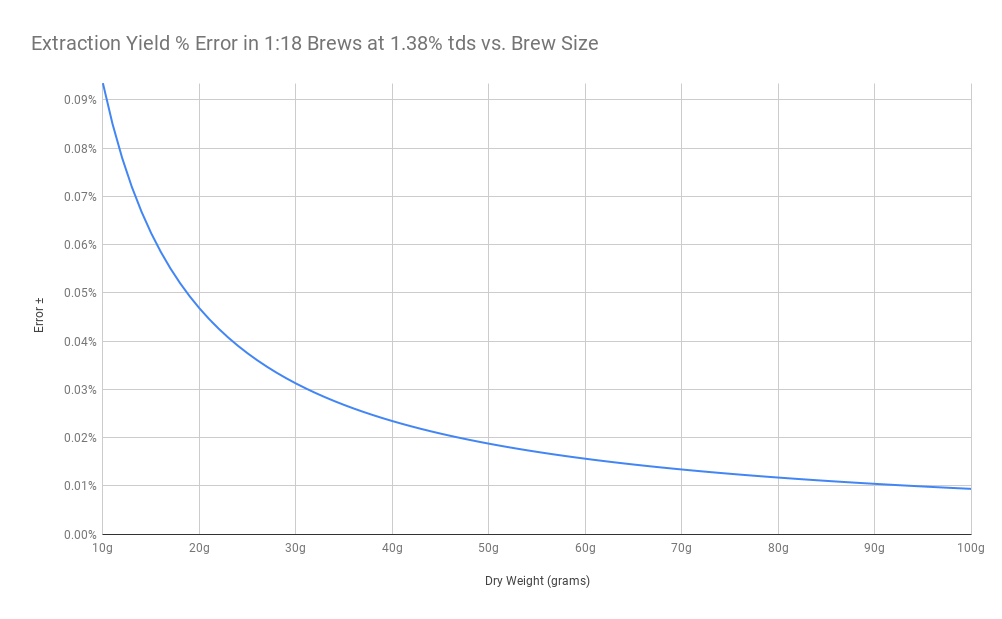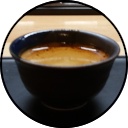What?
The hundredths place is (usually) useless in extraction yield with typical single cup pourover or espresso methods. You don’t actually know if your brew you measured at 23.04% extraction is actually 23.04% or maybe 22.98% extraction or 23.10% extraction.
Why?
Our scales aren’t good enough to know if changes to extraction in the hundredths are actually changes or errors in dose and yield measurements. That isn’t to say they’re not good enough for brewing coffee, you should just not care about changes to the hundredths because you have no idea if they’re real or not.
Because most scales used for coffee can only reliably measure to .1g, there’s .04g of uncertainty on either side. Your 15.0g could actually be 15.04g or 14.96g without changing the reading on your scale. This is a tiny change, small enough I highly doubt anyone could ever notice it, but hundredths in extraction are tiny too.
Let’s run some of these errors through \(\frac{TDS*Brew Mass}{Dose}\) and see what it looks like.
15:270
Our first brew is 15g coffee to 270g water, and weigh 240g beverage mass after the retained water (this problem is actually worse if you try to use LRR and don’t measure directly). TDS reads 1.38%, so we calculate extraction as 22.08%.
But that brew could just as well be 15.04g coffee to 239.96g beverage mass. Which makes for an extraction yield of 22.02%. .06% lower than we calculated.
And it could just as well be 14.96g coffee to 240.04g beverage mass. 22.14% extraction this time. .06% higher than calculated.
20:360
Let’s do something a bit bigger at 20g coffee to 360g water, 320g measured beverage mass. TDS reads 1.38% again, so we calculate extraction as 22.08% again.
If it’s actually 20.04g to 319.96g, extraction is only 22.03% (.05% lower than calculated) and if it’s actually 19.96g to 320.04g, extraction is up at 22.12% (.04% higher than calculated). Less than the smaller brew, but still too big to make the hundredths mean much of anything.
40:720
Let’s double that. 125g in, 720g water added, for a 640g beverage weight. Same 1.38% TDS and 22.08% extraction. Now we’re dealing with essentially up to .02% higher or lower extraction depending on the direction of error. So maybe at this size, the hundredth are more or less accurate. Although, I would argue, still unimportant.
Graphing the Trend
Ok, so I’m not going to go through every brew size one by one like that. But I will graph every input size from 10g up to 100g with a 1:18 brew at 1.38% tds.
 This apparently fits the curve \(Y=\frac{0.931}{X^-.999}\) with something the Google Sheets function that gave it to me calls “Power Series”. I don’t understand how they managed to generate that other than apparently it involves calculus, but the equation fits pretty well as long as you’re using over 10g. It does break down for extremely low inputs, but it can be used to estimate the calculated extraction yield error inherent with a .1g scale for any sane dose.
This apparently fits the curve \(Y=\frac{0.931}{X^-.999}\) with something the Google Sheets function that gave it to me calls “Power Series”. I don’t understand how they managed to generate that other than apparently it involves calculus, but the equation fits pretty well as long as you’re using over 10g. It does break down for extremely low inputs, but it can be used to estimate the calculated extraction yield error inherent with a .1g scale for any sane dose.
Note that other ratios and different target extraction yields WILL change this a bit, but it’s close enough to have the general idea with brewed coffee. For espresso it ends up being like ±.04% for huge doses and long shots to ±.10% for a smaller dose at 1:2.
Relation to TDS
Thanks to the way \(\frac{TDS*Brew Mass}{Dose}\) works, the amount .01% tds effects extraction is directly connected to the ratio of brew mass to dry weight for all coffee. Just shift the decimal on the beverage mass part of the ratio over by two.
For brewed coffee ratios, a change in .01% tds is still more significant than this error. A .01% tds change in a 1:18 brew with 2x dry weight LRR is a 0.16% change in extraction yield. A .01% change in tds definitely means something for extraction.
However for a shot, a .01% change in tds is only going to correspond to a .01% to .04% change in extraction yield depending on ratio. It doesn’t really mean too much of anything more than an error in dosing too small to measure on normal equipment. If you don’t care if your dose is 15g or 15.04g, maybe you shouldn’t care if your tds is 8.36% or 8.37% either. Also your measurement probably isn’t that precise anyway, but more on that in my next post.
Conclusions
Should you stop writing your hundredths place for extraction yield? You don’t have to, it’s not really hurting anything, but you should know it just doesn’t matter. Extraction yield is an estimation of an average, and you need to remember there are physical constraints on how finely we can pin it down besides just how good a refractometer is. Also maybe thought experiments on what water to use for zeroing a refractometer are stupid with this much of an error from other things, just use distilled and be done with it.
Should you start using a .01g scale to measure your dose? You can if you want. But my point in connecting it to changes as small as .04g on a scale is to show that a change in the hundredths of extraction is incredibly small. Don’t bother chasing microscopic geese.
